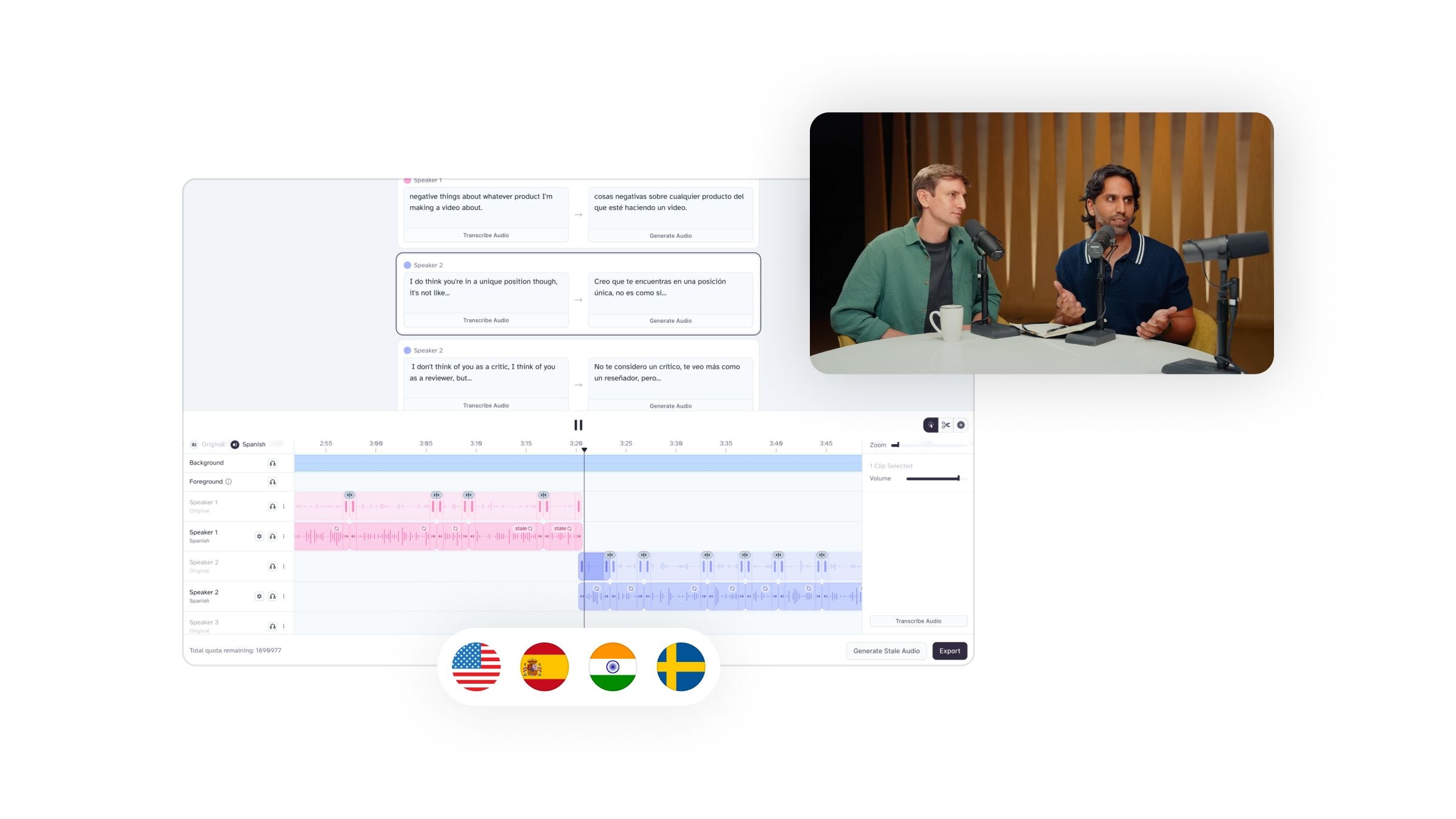
Translate audio and video while preserving the emotion, timing, tone and unique characteristics of each speaker
Learn how to localize your YouTube content and reach a global audience.

One effective way to expand your reach on YouTube is to take your content global by translating your videos into new languages.
For example, MrBeast—one of YouTube’s most popular creators—created a localized channel called MrBeast en Español. The results? Over 25 million new subscribers to his content.
He’s since merged that channel with his main channel via multi-track audio, but it just goes to show the power of localization when done right.
The localization process involves more than just translation. You need to consider cultural nuances, different internet speeds, subtitles, and more. Thankfully, with the right localization strategies, you can adapt your YouTube channel to effectively engage audiences worldwide.
Localized content will feel like it was created specifically for overseas viewers, helping increase watch time and subscribers from international audiences. While localizing your YouTube channel requires some upfront effort, it’s one of the best ways to tap into the platform’s truly global reach.
In this article, we’ll walk through a step-by-step guide to localizing a YouTube channel for global growth.
Localization on YouTube means making your channel and its content appealing to viewers in different regions by adapting it to their languages and cultural preferences. This is more than just translating words—it's about making your content feel relevant and relatable to people with different backgrounds. The aim is to make viewers feel like the content was created just for them, no matter where they are in the world.
Let’s explain how to identify your target audience(s), choose the right languages, and translate YouTube content into other languages.
You must first understand your target audience before venturing into localization. Who are they? What are their interests? Where are they from? YouTube’s expanded analytics report provides insights into your viewers’ age, gender, and geography, offering a closer look into the most engaged audience segments.
Once you understand these demographics, you can then create localized content that resonates with their wants and needs.
Selecting the appropriate target language(s) for localization is a strategic move that can significantly boost your YouTube channel’s viewership, number of subscribers, and potential for revenue gain. This involves understanding the global market potential and selecting languages that cater to a broad viewer base.
For example, you might choose to localize your content into any one of the world's most commonly spoken languages:
These languages are among the most commonly used for reaching diverse audiences in multiple languages. However, don’t just localize content into these language for the sake of it. If you have more viewers in other regions then prioritize the languages they speak.
Remember: the ultimate goal is to connect with your audience in their own language they understand and prefer, which will build trust and rapport.
In short, to make your YouTube channel more global, start by understanding your viewers: where they're from, what they enjoy, and what languages they speak.
If you're looking to maximize the revenue your channel generates, then you should also pay attention to the cost per mille (CPM) rates. In other words, how much ad revenue you can generate from a thousand views.
According to Blogger Nexus, these are the average CPM rates you can expect across different regions.
Advancements in technology have simplified the process for YouTubers to overcome language barriers and engage with global audiences. Innovative localization strategies, such as using AI technologies and automated tools, streamline the translation process and improve content accessibility.
For instance, YouTube’s auto-translate feature can provide quick translations for subtitles in the video’s default language. But translations alone aren’t enough. What if you want to narrate videos in another language?
YouTube's multi-language audio feature can significantly enhance your video's accessibility and global reach. Here’s how you can effectively use this newly released feature.
An example of multi-language audio tracks from one of Mr Beast’s videos
What if you’ve uploaded a multi-language audio track and want to replace it with a new version? In this case, follow these steps:
Head to “Audio” and click the Delete button for the appropriate language
Note that the multi-language audio feature on YouTube isn't yet accessible to all users. For instance, Mr Beast is an example of a high-profile channel that utilizes this feature to reach a global audience.
However, for creators who don't have access to this functionality, there are alternative strategies to consider. For example, Steven & Parker opted to launch separate channels in Spanish and Portuguese to cater to their diverse viewer base. This method allows creators to broaden their reach and engage with international audiences, even without direct access to the multi-language audio feature.
It’s important to be aware that this YouTube feature doesn’t automatically generate dubbed audio tracks—creators have to record dubbed audio tracks before uploading. For example, by using ElevenLabs' Dubbing Tool.
ElevenLabs’ Dubbing tool allows creators to near-instantly localize high-quality voice content in 29 languages. It’s quicker, easier, and cheaper than hiring a voice actor. It’s the future of localization.
Get started today with ElevenLabs’ Dubbing tool.

Translate audio and video while preserving the emotion, timing, tone and unique characteristics of each speaker
Adapting your content for different markets may involve more than translation. Consider cultural nuances, local trends, and regional humor. The goal is to make each video feel like it was created specifically for that audience. This might mean altering or creating content based on local interests or local events.
YouTube offers several features to support localization. Use these tools to your advantage:
You might question whether it’s better to retain a single YouTube channel with multilingual content or establish separate channels for different languages. Both approaches have their pros and cons.
Creating personalized ads will increase conversion rates, deepen customer relationships, improve brand loyalty, and lead to a higher ROI from advertising efforts.
These ads are more scalable than direct one-to-one video targeting, as they allow you to edit existing content to suit different audiences in a specific language. You can also use geolocation settings to show personalized ads depending on where viewers are based. This will ensure your videos appear in search results and recommendations for viewers in those locations, depending on your settings.
Moreover, you can use YouTube’s end screen features to promote videos and tailor recommendations to international viewers based on their cultural interests.
Creating these ads enhances the personalized experience for an international audience on YouTube. Showing ads that are relevant to the viewer’s interests increases the likelihood of engagement and conversion. This allows your audience to easily find and consume content that resonates with their interests and cultural context, while also helping you track outages and protect your platform’s performance.
Interacting with local communities is a potent method to boost visibility and pique audience interest. This could involve:
Engagement can also be enhanced by hosting Q&A sessions and local meet-ups, providing opportunities for direct, community-focused interaction. Remember that building a diverse and welcoming online community involves actively moderating comments to promote inclusivity and make sure the international audience feels included.
Localization also entails customizing the user experience on your YouTube channel. This can be achieved by:
Localizing your YouTube channel is crucial for several reasons:
Localization is a continuous process that necessitates regular monitoring and revisions. Using YouTube Analytics, you can track critical performance indicators such as:
These metrics offer insights into user interaction with localized videos and help measure content reach, engagement, and site statistics.
Subscriber growth reports and re-watches provide quantitative data on audience growth and interests, signaling the effectiveness of the localized content. With YouTube Analytics’ Advanced Mode, you can create custom charts and comparisons, and export analytics for a comprehensive evaluation of your localization strategies. This data analytics helps identify what’s working, what’s not, and where improvements can be made.
Localizing your channel is a powerful strategy to unlock global potential, increase viewer engagement, and cater to diverse global audience. From understanding your target audience and choosing the right target language to adopting innovative localization strategies and leveraging YouTube’s advanced features, each step plays a crucial role in the localization journey.
Ready to begin localizing your content? Get started with ElevenLabs’ AI Dubbing tool to effortlessly translate your existing videos.

Translate audio and video while preserving the emotion, timing, tone and unique characteristics of each speaker

Introducing a set of updates that expand what creators and developers can build with Eleven Music.

Increasing physician reach by 30% and cutting admin time by 10 hrs/week
Powered by ElevenLabs Agents